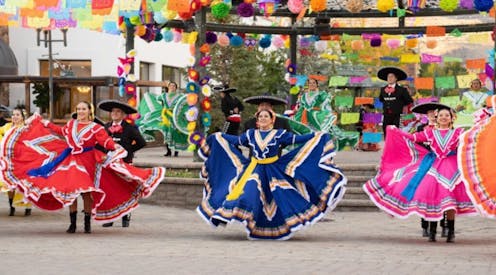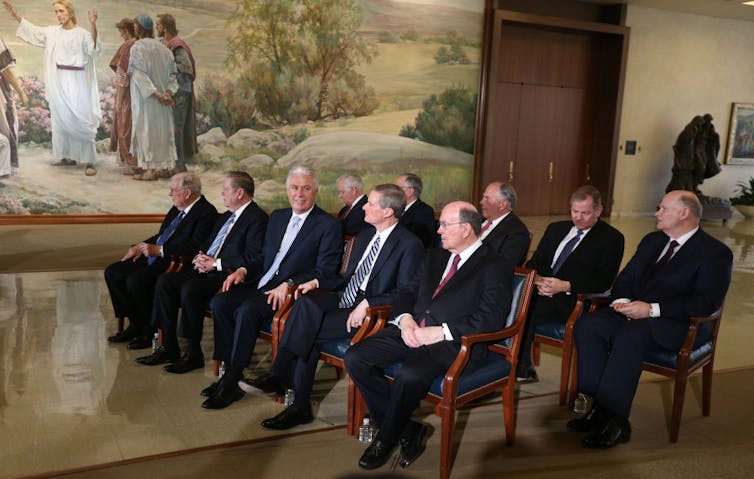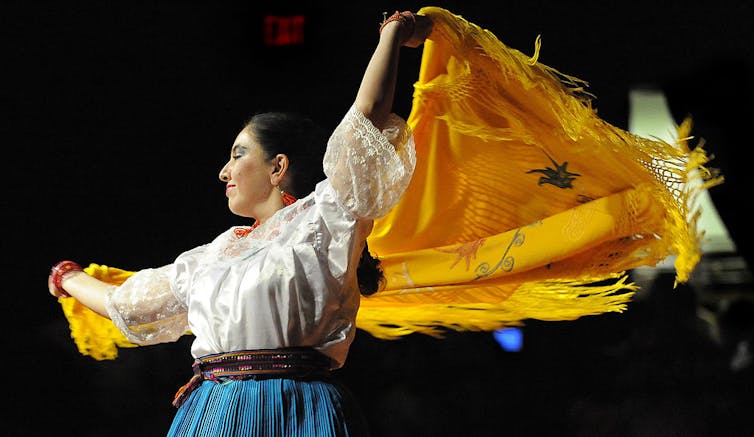
Every November since 2002, the Church of Jesus Christ of Latter-day Saints has held an annual show called “Luz de las Naciones,” or “Light of the Nations.” With a cast of more than 500, most of whom are Latino members of the church, the program incorporates music, dancing and spiritual messages in a celebration of Latino identity across cultures.
The theme for 2022 is “Juntos es Mejor,” which means “Better Together.” The free program is held in the LDS Conference Center, just north of the famous Temple Square in Salt Lake City, Utah: headquarters of the Church of Jesus Christ of Latter-day Saints, also historically known as the Mormon or LDS church. Luz de las Naciones is the only annual long-standing multilingual and multicultural televised celebration sponsored by the church headquarters.
As a scholar of immigration, race and religion, particularly in the LDS church, I often encounter a stereotype that it is overwhelmingly conservative, white and American. Yet that is increasingly not the case. What was once a tiny religious movement has grown into a global faith with almost 17 million members, by the church’s count, and over 60% of members live outside the United States. Using LDS church statistics and Pew Research reports, I estimate around 40% of members worldwide are from Latin America, or descended from people who are.
Two-century transformation
Many stereotypes about the LDS church are rooted in its controversial history. Joseph Smith established the faith in 1830 in New York state, and early members moved to Ohio, then Missouri and then Illinois before they settled in present-day Utah, which led to conflicts and displacement of local Native American groups. Even today, LDS influence is strongest in the so-called Mormon Corridor: states in the western U.S. with large LDS populations, including Utah, Nevada, Idaho and Arizona.
Despite facing hostility in the church’s early decades, leaders emphasized the importance of evangelizing. This focus on “every member a missionary” resulted in one of the most organized worldwide missionary programs and, ultimately, large membership growth abroad. In the U.S., the primary sources of growth are Latinos, and there is continued push for immigrant outreach.
Leaders vs. reality
My ethnographic research focuses on the experiences of Latina Mormon mothers in the U.S. and internationally, highlighting the diversity of the modern church. One likely reason this diversity sometimes surprises Americans is the lack of representation within institutional LDS leadership.

Only nine of the 130 roles in the church’s main leadership bodies, about 7%, are open to women. Of those nine, seven are currently held by U.S.-born white women. All are in temporary roles, often limited to a few years. More top roles reserved for men, on the other hand, are lifelong appointments. LDS congregations do not have ordained clergy, but all male members as young as 12 who are considered “worthy” are ordained into what is called the priesthood. Priesthood holders are believed to possess spiritual authority that empowers them to act in God’s name. Yet LDS women cannot be ordained to the priesthood, limiting their opportunities for formal leadership.
Over the years, highly publicized public messaging campaigns like “I’m a Mormon” have sought to subvert common assumptions about LDS doctrine and culture, but stereotypes endure. Events like Luz de las Naciones show institutional attempts to create a more international and multicultural image, specifically regarding Latino members. Beginning in 2021, for example, the church began a bilingual campaign using the holiday Dia de los Muertos as a way for members to share its teachings about life after death.
Latino Saints
In my three years of fieldwork in the U.S. Southwest, I have found that Latina women, in particular, are a backbone of local growth and support for the church, with more women active in their local congregations than men. Although women do not hold many institutionalized leadership positions, they are typically entrusted with the informal labor and community-building that is necessary for both small activities like congregational holiday parties or large-scale events like Luz de las Naciones. They often take on these responsibilities with limited institutional support or resources.
Many women I interviewed between 2018 and 2021 felt great pride and satisfaction in contributing to the LDS community in this way, but also described frequent experiences of sexism, racism and discrimination by American-born members. Ana, a pseudonym for a member who is originally from El Salvador, told me she’s met non-Latino church members who are “super sweet, but many are very sheltered … it’s difficult for them to accept us … to see things from our perspective … they don’t know our experience.”
Another Latina member from Argentina, “Camila,” told me: “Anglo members didn’t really talk to us or give us service opportunities. For a couple years, church did not feel the same. We decided to go the Spanish-speaking LDS congregation. There, I met some of my best friends. Things changed, and we were happier.” Both my research and other scholars’ studies have addressed these seeming contradictions and tensions in Latino members’ complicated experiences.

These cultural divides felt particularly strong in areas where immigration has been deeply politicized. Arizona, for example, passed the controversial SB1070 in 2010, requiring immigrants to carry documentation of their legal status at all times and permitting law enforcement to demand it from anyone they deemed suspicious during traffic stops. SB1070 was widely criticized as a form of racial profiling and one of the most extreme anti-immigration laws at the time.
SB1070 was sponsored by state Sen. Russell Pearce, a former sheriff and member of the LDS church. He was defeated in a recall election shortly afterward by charter school executive Jerry Lewis, a Republican and local Mormon leader who opposed Pearce’s stance on undocumented immigration.
The overarching whiteness and conservatism of LDS leaders – both in politics and in the church – were often a point of contention for Latina Mormons I interviewed. “Nora,” a Mexican mother of two, told me that the fallout over immigration politics was “unbelievable,” causing “so much of the church’s reputation to be damaged.” She described members who support immigrants, like Lewis, as “sent from heaven.”
Although there has been an alarming rise in online support for white supremacy among U.S. LDS membership, there are also ongoing significant efforts on the part of LDS progressives to rethink the church’s approaches to diversity and inclusion. As the Luz de las Naciones event emphasizes, parts of the church and its membership welcome the idea that it is “Better Together.”
Brittany Romanello does not work for, consult, own shares in or receive funding from any company or organization that would benefit from this article, and has disclosed no relevant affiliations beyond their academic appointment.
This article was originally published on The Conversation. Read the original article.







